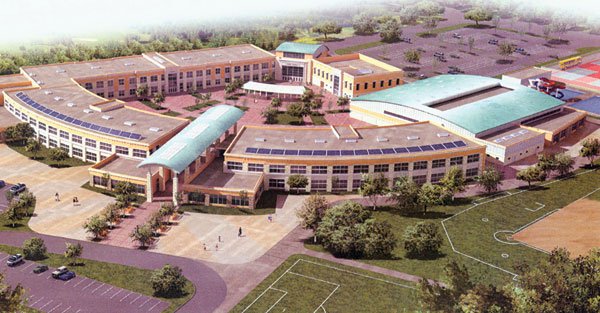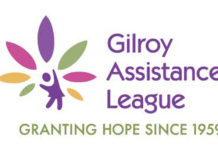The school district has a major cash flow problem.
Now the board plans to ask voters if they would help close a $23
million gap in funding for phase I of Christopher High School, a
project that is well on its way to completion.
The school district has a major cash flow problem.
Now the board plans to ask voters if they would help close a $23 million gap in funding for phase I of Christopher High School, a project that is well on its way to completion.
Back in 2002, voters passed Measure I, a $69 million bond to fund two new elementary schools, a new student center at Gilroy High School, districtwide facilities upgrades and repairs, and the first phase of CHS, which originally had a price tag of $39 million including $6 million worth of land. Measure I went a long way, but not far enough, trustees said. That $39 million price tag grew over the years to today’s $123 million figure.
However, phase I now includes many projects that were never on the original list. An additional $30.9 worth of projects was added over the years, when the board believed it would have the funds to pay for them. But they don’t now that two plots of land worth an estimated $25 million aren’t selling.
“In reality, when we go out and tell people we need money to help us with the shortfall of phase I … we’re also looking at money for phase II, because we’ve added phase II elements to phase I of the project, Aguirre said. “It’s important for all of us to be on the same page to understand what phase I meant to the voters back in November of 2002.”
“It’s always easier to look backwards than to look forwards,” Superintendent Deborah Flores said. “I have no doubt that the good people who were involved from the beginning of this project did the best they could with the information they had in hand at the time to plan for the cost of this project. However, no one could have predicted six to seven years ago the cost escalations that would occur over that time frame, that the housing and commercial markets would spiral downward as quickly as they have. All of these factors and others have negatively impacted the budget for Christopher High School.”
The board intended to fund phase I with Measure I money, but needed additional sources of funding, like the sale of the properties, to fund skyrocketing prices.
Now realizing the land won’t sell for the asking price, district staff presented the board with several options for CHS: shutting the project down, reducing the project scope or changing the design, selling the land at a reduced value or putting a bond measure before voters to raise the money needed to finish phase I.
The district is in the process of conducting a voter opinion survey to gauge the community’s reaction to the last option. In the meantime, Gilbane, the general contractor, was expected to begin pouring the cement foundations for the administration, theater and classrooms Monday, architect Paul Bunton informed the board. On top of the $23 million shortfall from the district properties, Bunton identified a $3.6 million deficit in projected state funding. The firm is working to mitigate that shortfall by moving two canopies, worth $2.217 million, to phase II.
“They’re not functional parts of the building, but they’re great architectural pieces of the school,” Bunton said. “There’s very little else we can take out of this project.”
“Costs are skyrocketing, we’re getting less funding,” Trustee Denise Apuzzo said. “It doesn’t bode well for us if we keep seeing these numbers we have faith in and then find out in the 11th hour, ‘Well, that number’s not a real number.’ ”
Additionally, when the district found out that it would be receiving less state money, staff decided not to go through an appeals process because it would delay the delivery of the funds that were still available. Flores said this decision was made by former Assistant Superintendent of Business Services Steve Brinkman.
“I’m not judging that decision,” Trustee Francisco Dominguez said. “But there needs to be a better process of informing us.”
Dominguez was uncomfortable with the stability of funding sources back in August, however, and he pointed out that there were “too many ifs.” At an August 2007 board meeting, members authorized Gilbane to solicit bids for site work and buildings despite an estimated $15 million gap in funding. Trustees Jaime Rosso and Rhoda Bress were absent. Trustees Javier Aguirre, Denise Apuzzo and Patricia Midtgaard voted in favor. Trustees Francisco Dominguez and Tom Bundros opposed the vote. The vote carried and the project moved forward.
“The financing was not there,” Dominguez said. “Today, the scenarios are playing themselves out. My position now, we need to be better informed. The board has to make critical decisions about prioritizing where we want to go with this project. We’ve been left out of the loop and been informed after the fact. I’m trying to be as patient as possible.”
“I see the only real viable option points to a clear need to pursue a general obligation bond,” Rosso said. He pointed out that the district’s assets are there, but the land simply can’t be sold at it’s potential value at this point. “The dilemma is a cash flow problem. We wouldn’t be in this dilemma if we could liquidate, if we could sell the land.”
“The biggest problem for me is … we passed a $39 million dollar school bond that, even if we hadn’t added anything else in, is now $91 million dollars,” Apuzzo said. “So now we have to go back to the voters if we decide on a (general obligation) bond and say we have a $23 million shortfall just to complete phase I when all along the discussion has been the possibility of going for a (general obligation) bond for completing phase II.”
The cost of the future bond would be to complete phase I, plan for a new elementary school and complete phase II of CHS, she said.
“I think we need to be really upfront with the people of Gilroy and say we’re looking at a $200 million dollar high school,” she said. “Can this community afford a $200 million dollar high school? It’s a discussion nobody wants to have but I think we need to have it. We keep coming before the voters and say this is going to close the funding gap … we need to go to a (general obligation) bond for phase I at this point … I just want to come up with a solution that works.”
Christopher High costs
2000 – $33M (+ $6M in land)
2001 – $35M
2002 – $37M
2003 – $40M
2004 – $44M
2005 – $53M
2006 – $61M
2007 – $66M
2008 – $72M
+ $20M in land)
+ $30.9M in additional projects
Total = $123M














